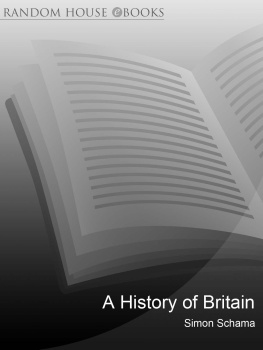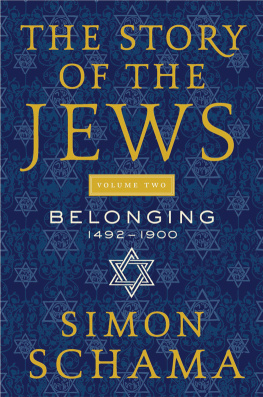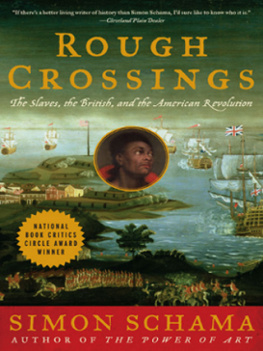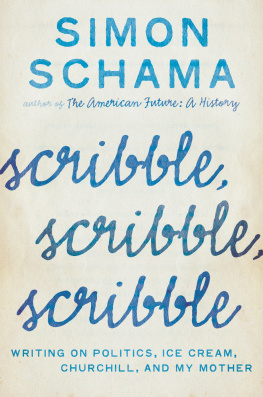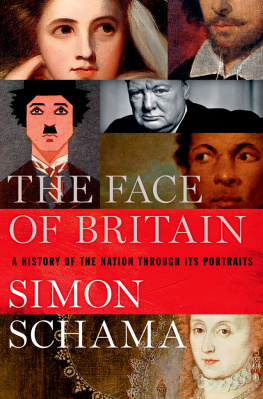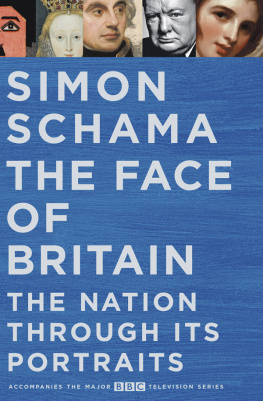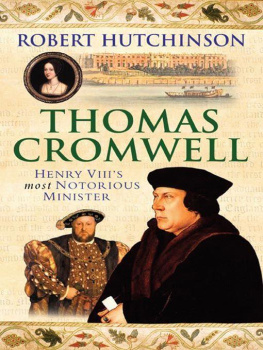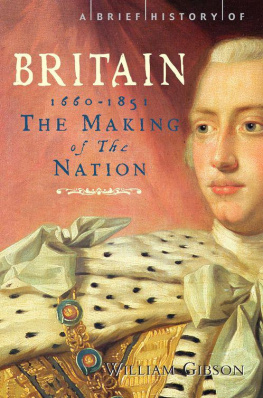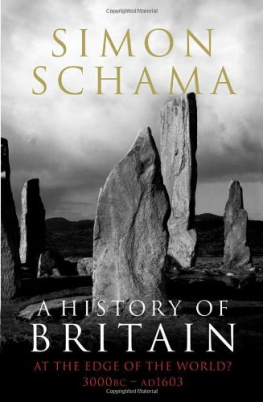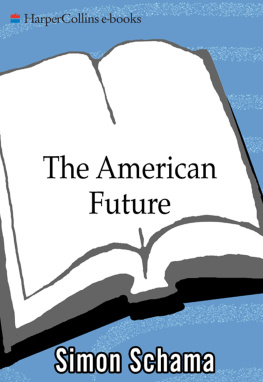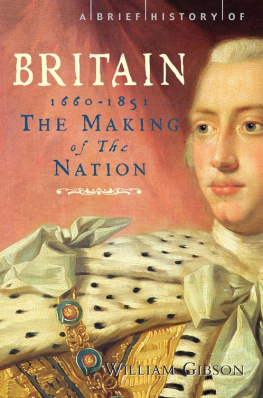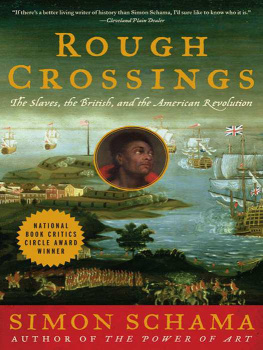CONTENTS
A History of Britain
At the Edge of the World?
3000 BCAD 1603
Simon Schama

The cradle rocks above an abyss, and common sense tells us that our existence is but a brief crack of light between two eternities of darkness... Nature expects a full grown man to accept the two black voids, fore and aft, as stolidly as he accepts the extraordinary visions in between. Imagination, the supreme delight of the immortal and the immature, should be limited. In order to enjoy life we should not enjoy it too much. I rebel against this state of affairs.
VLADIMIR NABOKOV, Speak, Memory
I shall cheerfully bear the reproach of having descended below the dignity of history if I can succeed in placing before the English of the nineteenth century a true picture of the life of their ancestors.
THOMAS BABINGTON MACAULAY, The History of England
Those conquered kings pass furiously away; gods die in flesh and spirit and live in print each library a misquoted tyrants home.
ROBERT LOWELL, End of a Year from History
PREFACE
HISTORY CLINGS TIGHT but it also kicks loose. Disruption, as much as persistence, is its proper subject. So although the great theme of British history seen from the twentieth century is endurance, its counter-point, seen from the twenty-first, must be alteration.
Both hanging on and letting go made themselves felt in the two public ceremonies a drizzly coronation and a frost-nipped funeral which spoke most powerfully to my post-war generation about what it meant to be British. Admittedly, in June 1953 a bracing sense of change was not the most obviously dominant mood. Two years before, in the Festival of Britain (a self-consciously centennial commemoration of the Victorian Great Exhibition of 1851), there had been a strenuous official attempt to persuade us eight-year-olds, in our grey flannel shorts and saggy knee-socks, that we should now think of ourselves as New Elizabethans. The heraldic symbol of the coming technological Valhalla was the Skylon Brancusi out of Isambard Kingdom Brunel a slender steel cylinder, tapering to points at both ends like an industrial bobbin and suspended by cables so light that it seemed to float a few feet over the South Bank promenade with no visible means of support. But in the spring of 1953 bewitching visions of a sleekly engineered scientific future did, indeed, weigh nothing beside the vast machinery of reverence being cranked up for the coronation of Elizabeth II. To be sure, fitful efforts had been made to advertise the event as a moment of rejuvenating change. But no one was really fooled. For all the communiqus about an association of free nations, the Commonwealth over which the young queen presided was, transparently, the brave face put on the loss of empire. The parade of pith-helmeted and bush-hatted troops from the loyal dominions along with more exotic detachments from what were still, in 1953, known as British possessions dutifully trotted along the Mall in their allotted order a post-imperial durbar in all but name. And when the queen set off on her post-coronation world tour, primary school children like us followed her progress by sticking little flags in all the many regions of the globe still (no matter what their ostensible status in the modern world) reassuringly tinted the dusty rose-red of the old empire. In William McElwees The Story of England, published in 1954, it was still possible to look forward to the peaceful evolution of backward races throughout the empire made possible under British leadership. And the faces behind the net curtains in Omdurman Gardens and Mafeking Close were still those of the colonizers, not the colonized.
There was one gawky contemporary cuckoo growing apace in the nest of tradition, and that, of course, was television. But although the broadcast of the ceremony in Westminster Abbey, seen by 27 million viewers within Britain and as many as a quarter of the worlds population in all, was an epochal moment in the history of mass communications, it very nearly didnt happen. For months the queen herself and all her principal advisers let it be known that while they were prepared to have the processions to and from the abbey televised (as had also been the case with her wedding in 1947), the ceremony of the crowning itself was to be preserved in its sacrosanct mystery from the common electronic gaze. Eventually swayed, it has been suggested, by the intervention of Richard Dimbleby she relented. But to re-run that television coverage is to see just how completely the latent cheekiness of the medium was subdued by the enfolding stateliness of the coronation rituals. The cameras were put in their place and made to stand up straight where they were told and to pay attention when they were bidden. Anything as intimate as a close-up of the queen herself, needless to say, was strictly prohibited, so that many of the most memorable shots of the ceremony are the remote views from the galleries high above the nave, peering down at the grandeur. And whatever the credits might have read, the real producers of the event were the Duke of Edinburgh, in his capacity as Chairman of the Coronation Executive Committee; the Archbishop of Canterbury, Geoffrey Fisher, who was intent on maximizing the mystical and sacrificial aspects of the rite; the Grand Chamberlain, the Marquess of Cholmondeley; and, most important of all, the Earl Marshal, the Duke of Norfolk, who was required to rule on matters as critical as whether rabbit-fur was an acceptable substitute for ermine on the trim of aristocratic robes. (It was.) Over the black-and-white pictures (which themselves have the quality of official state photographs) poured, with honeyed smoothness, the deferentially modulated tones of the commentators-royal: the ripely hushed baritone of Richard Dimbleby for the abbey solemnities and the excitable, lilting tenor of Wynford Vaughan Thomas for the street procession. For that matter, the twenty-seven-year-old at the centre of all this seemed herself to have been crystallized, as if in some ceremonial alembic, into the role of monarch, the open, often broadly smiling face of the young woman settling into the impassive mask of royalty. Millions of the loyal, gathered in front rooms, peering at the 9-inch screens that had been magnified with strap-on image enhancers, watched the heavily crowned, massively mantled figure, the train flowing endlessly behind her, as she swayed down the nave of Westminster Abbey to the roar of the choir and the oceanic swell of the organ, the ancient Saxon-Frankish shout May the queen live forever echoing off the columns.
Out in the streets and in the country, novelty was certainly not uppermost in the national mind-set. Analogies between the two Elizabethan reigns were endlessly drummed home. The Earl Marshal was, after all, a Howard Duke of Norfolk, just as there had been a Howard Norfolk Earl Marshal for the coronation of the first Elizabeth. The Souvenir Book for Essex Children emphasized the parallels between the reign of the first Elizabeth: a time when the English people faced a crisis, namely the great struggle with Spain. Now in 1953 Queen Elizabeth the Second has come to the throne at an equally critical time. Two great wars have been fought when the nation has stood and suffered. But, it promised, if we are loyal and steadfast, history will tell that the reign of our Queen Elizabeth will be worthy to rank with that other Good Queen Bess.
With all this fixation on the unbroken continuity of British history, it seemed only natural (or, at the very least, fated) that it should be Winston Churchill who should be in office as prime minister, presiding over the accession and enthronement of the new monarch. For in Churchills person the classical distinction between history as deed and history as report had become moot. Looking back over his entire career, had there ever been a time when Churchill had not both written about, and acted on, British history? Two weeks before the coronation, at a lunch for Commonwealth parliamentarians, Churchill told an American schoolboy (who, for better or worse, would go on to be a presidential speech-writer): Study history, history, history. In history, lie all the secrets of statecraft. Certainly, in his own mind the writing and doing were so entangled that it was virtually impossible to say which was cause and which effect. Even at the hour of supreme crisis in 1940, it might be argued, the difference that Churchill made to the destiny of the nation was as much a matter of words as deeds: his instinctive (and perfectly justified) belief that to bet on the future it was indispensable to reconnect the country with its passion for its past. Although he was in his late seventies at the time of the coronation, Churchill seemed virtually imperishable, clearly enjoying reminding the queen at a great banquet held beneath the medieval hammerbeam roof of Westminster Hall that he had faithfully served her great-great-grandmother (Victoria), her great-grandfather (Edward VII), her grandfather (George V), her father (George VI) and now her. And the tutelary partnership between this young queen and the indomitable patriarch seemed to both press and public a perfect emblem of the happy marriage between old and new that was supposed to typify the coming epoch of the new Elizabethans.

